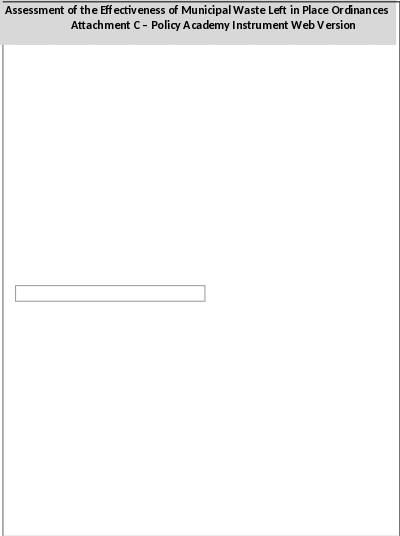Assessment of the Effectiveness of Municipal Waste Left
Information Collections to Advance State, Tribal, Local and Territorial (STLT) Governmental Agency System Performance, Capacity, and Program Delivery
Attachment C Policy Academy Instrument_WebVersion
Assessment of Waste Left in Place (WLIP) Ordinances
OMB: 0920-0879

Form
Approved OMB
No. 0920-0879 Expiration
Date 03/31/2018
ATSDR estimates the average public reporting burden for this collection of information as 4 minutes per response, including the time for reviewing instructions, searching existing data/information sources, gathering and maintaining the data/information needed, and completing and reviewing the collection of information. An agency may not conduct or sponsor, and a person is not required to respond to a collection of information unless it displays a currently valid OMB control number. Send comments regarding this burden estimate or any other aspect of this collection of information, including suggestions for reducing burden to CDC/ATSDR Information Collection Review Office, 1600 Clifton Road NE, MS D-74, Atlanta, Georgia 30333; ATTN: PRA (0920-0879).
Introduction: The Agency for Toxic Substances and Disease Registry (ATSDR) works to prevent exposures to hazardous chemicals. Exposure to hazardous chemicals can lead to adverse or negative health effects. People can sometimes come into contact with hazardous chemicals left behind when industries go out of business and abandon a property / facility. These abandoned properties or facilities are called “brownfields”.
A brownfield may be an abandoned, idled, or underused industrial, commercial, or residential property where reuse or redevelopment may be hindered by real or perceived contamination.
Some municipalities have put into place ordinances to help prevent this situation from happening. ATSDR refers to these as “waste left in place” (WLIP) ordinances. Municipalities may call them Vacant Property Registration Ordinances with clauses for contamination or waste.
ATSDR is interested in learning more these ordinances. ATSDR is conducting a short assessment to find out how these ordinances are being used to protect people from being exposed to hazardous chemicals. You are being asked to participate in this assessment because you are an environmental or municipal official in your community. This assessment should only take about 4 minutes of your time.
What is your official title?
What is the size of your municipality, town, or city?
Less than 1000 people 1000 – 4999 people
5000 – 9999 people
10,000 – 24,999 people
25,000 – 49,999 people
50,000 – 99,999 people
100,000 – 299,999 people
300,000 – 499,999 people
500,000 – 999,000 people
1,000,000 or more people
 Does
your
municipality
have
ordinances
(sometimes
referred
to
as
waste
left
in
place
Does
your
municipality
have
ordinances
(sometimes
referred
to
as
waste
left
in
place
ordinances) designed to prevent hazardous waste from being left behind when commercial, industrial, or residential facilities close or are abandoned?
![]() Yes
Yes
![]() No
No
![]() Don't
know
Don't
know
In the previous question you indicated that you were aware of "waste left in place" ordinances in your community. Please describe them below. Be sure to indicate what types of waste and property they cover and if applicable, include a link to the ordinance.

Please describe who enforces these ordinances in your municipality.

How often would you say these ordinances are enforced in your community?
![]() All
the
time
All
the
time
![]() Most
of
the
time
(75-99%)
Most
of
the
time
(75-99%)
![]() About
half
of
the
time
(50-75%)
About
half
of
the
time
(50-75%)
![]() Less
than
half
of
the
time
(25-49%)
Less
than
half
of
the
time
(25-49%)
![]() Rarely
(less
than
25%
of
the
time)
Rarely
(less
than
25%
of
the
time)
![]() Never
Never
![]() Don't
know
Don't
know
What are the penalties for not following these ordinances? Choose all that apply.
 Fines
Fines

 Legal
action
Don't
know
Legal
action
Don't
know
Other (please specify)

 How
effective
have
these
ordinances
been
at
preventing
these
properties
from
becoming
brownfields?
How
effective
have
these
ordinances
been
at
preventing
these
properties
from
becoming
brownfields?
![]() Very
effective
Very
effective
![]() Somewhat
effective
Somewhat
effective
![]() Neither
effective
or
ineffective
Neither
effective
or
ineffective
![]() Somewhat
ineffective
Somewhat
ineffective
![]() Completelyineffective
Completelyineffective
![]() Don't
know
Don't
know
Please explain your answer to the previous question in the space below.


| File Type | application/vnd.openxmlformats-officedocument.wordprocessingml.document |
| File Title | View Survey |
| Author | Gilliam, Adzua H. (CDC/OSTLTS/DPHPI) |
| File Modified | 0000-00-00 |
| File Created | 2021-01-26 |
© 2025 OMB.report | Privacy Policy